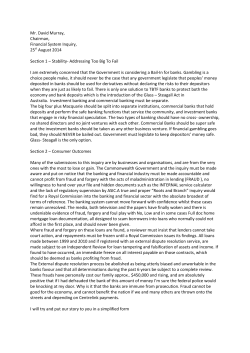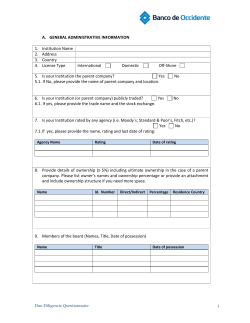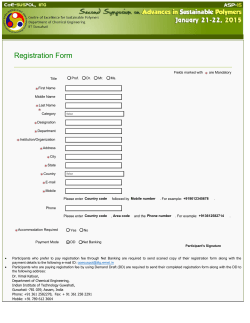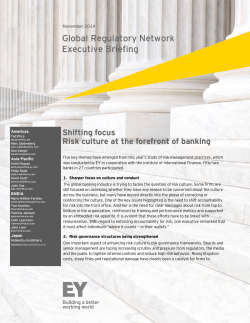
28 RESEARCH NEWSLETTER No.
RESEARCH NEWSLETTER No. 28 (October 2014) LATEST NEWS DNB Household Survey received Data Seal of Approval foreign banks has stayed rather stable, substantial differences between "The DNB Household Survey (DHS) has received the Data Seal of Approval countries exist with some countries experiencing a sharp reduction in (DSA) in August 2014. This international data label, established by a number foreign ownership and others an increase. Furthermore, due to the of institutions committed to the long-term archiving of research data, indicates withdrawal of some advanced economy banks, emerging market banks that the data is stored safely and in a sustainable way, and that they have are starting to play a more prominent role. This has resulted in the been thoroughly checked for accuracy. The DSA is assigned by the DSA global financial system becoming more regional in the wake of the Board and renewed every year through a modification procedure. The Board global financial crisis. consists of members from the following institutes: Alfred Wegener Institute The conference keynote speakers were Charles Calomiris (Colombia (Germany), CINES (France), DANS (The Netherlands), ICPSR (USA), MPI for Business School) and Martin Hellwig (Max Planck Institute). Charles Psycholinguistics (The Netherlands), NESTOR (Germany) and UK Data Calomiris discussed theory, empirics and policy with respect to bank Archive (United Kingdom)." capital regulation. He argued that raising minimum capital requirements has both social benefits but also costs, but that a good case can be CONFERENCES made for substantially raising the requirements (to around 10% of 12-13 June 2014 - International Banking: Microfoundations and assets). However, to be most effective other tools need to be used as Macroeconomic Implications well, specifically CoCos and cash requirements. Martin Hellwig focused Programme: link on the need for banks to substantially increase capital ratios in order for the financial system to become more stable as discussed in his book On June 12-13 a conference on International Banking took place at De “The Banker’s New Clothes” that he wrote jointly with Anat Admati. He Nederlandsche Bank (DNB). argued that even though new regulation that has been put in place after The conference provided a forum for researchers to discuss innovative ways the collapse of Lehman Brother’s made the financial system safer, it is to measure and model how the activities of internationally active banks interact still far from safe and therefore more needs to be done. with the real economy. The conference was organized jointly by DNB, the IMF During the conference both theoretical and empirical papers were and IMF Economic Review. Selected papers will be published in a special presented and it was clear that a lot of progress has recently being issue of the IMF Economic Review. made in trying to understand what makes banks become internationally In his welcome speech DNB governor Klaas Knot showed how the crisis has active and what the consequences are of international active banks. affected international banking. While the global share of bank assets owned Papers addressed a variety of topics including how banks transmit -2shocks internationally, the driving forces behind banking FDI and cross-border bank flows, the impact of global capital on financial fragility and the differences between intra and interbank flows. There was one presentation by a DNB researcher. Neeltje van Horen presented her paper (Shocks abroad, pain at home?) with Steven Ongena (Zurich University) and Jose Luis Peydro (Universitat Pompeu Fabra and Cass Business School). Using a unique matched bank-firm level data for over 45,000 firms active in 14 Eastern European and Central Asian countries the authors show that foreign owned banks and domestic banks that had borrowed from the international capital market reduced credit to firms with negative consequences for the financing and real performance of firm’s dependent on this credit. These negative consequences were especially severe for firms with a single bank relationship, small firms or firms with limited tangible assets. Firms in countries with lower growth or financial development, more reliance on foreign funding or slower contract enforcement were also affected more. The results clearly point towards the existence of spillover effects to the real sector through an international banking channel. INTRODUCING MARTIN VAN DEN BERG In september 2012 I joined DNB as an enterprise architect. At the same time I started with a PhD in that area. Let me first introduce myself. I’m an enterprise architect with more than 15 years’ experience in this area. I graduated at the Tilburg University with a degree in Business Economics. In 1984 I started my working career in the IT. I worked as a programmer, systems analyst and project manager. But once architecture gained a foothold in the Netherlands, I found my area of choice and managed to become one of the experts in this field. I worked as an architect in organizations like ABN AMRO, ING, Rabobank and Shell. In September 2012 I joined DNB and found a place where I can combine practice and research in the area of enterprise architecture. I’m one of the founders of an architecture framework called “DYA”, DYnamic Architecture, and co-authored three books on DYA. DYA is one of the most popular architecture frameworks in The Netherlands and Sweden. I teach architecture in the Master of Informatics at Hogeschool Utrecht. I am also a member of the program board of the annual Dutch Architecture Conference which is one of the largest IT-conferences in The Netherlands with about 600-700 visitors. The subject of my PhD is enterprise architecture and IT decisionmaking. Enterprise architecture (EA) is a relatively young discipline which is seeking ways to fully exploit its potential. EA can be considered -3both a design discipline and a business function. As a design discipline, EA is A finding from the systematic literature review was the lack of literature an instrument to create a high-level design of the future state of an enterprise on how exactly IT decision-making takes place. That is the reason why I covering both business processes and IT capabilities. As a business function am now conducting a case study at DNB. The objective of this case EA supports senior management in making decisions with regard to the design study is to find answers on the following research questions: and evolution of the enterprise. One of the key outputs of the EA function is What kind of IT decisions are made at DNB? improved decision-making regarding the solutions to complex organizational How are these IT decisions made? What kind of variables and problems. That raises the question to what extent EA is used in decision- factors do play a role? What is the process that is followed? making and whether decision-making does indeed improve when EA is Who makes the decision? involved. Most EA definitions explicitly mention the areas that constitute the Who provides input for the decision? design of a future enterprise. Information systems (IS) and information What is the role of the enterprise architecture function in these technology (IT) are among these areas, indicated by terms like information decisions? systems, applications and IT infrastructure. It was in fact the IS discipline If you are interested in my research please give me a call or drop me an where the notion of EA originated with the Zachman framework. If effects of email. You can reach me at: m.j.b.k.van.den.berg@dnb.nl. EA on decision-making would be visible, IS and IT should certainly be the areas to look for. However, little is known of how IS and IT decisions have PAPERS improved due to EA. It seems as if a big gap exists between the current and “Diagnosing the distribution of GARCH innovations”, Chen Zhou desired state of decision-making as an EA objective. Previous research A new paper by Chen Zhou (jointly with Pengfei Sun (Deutsche Bank)) indicates that although EA provides valuable insights, these insights have entitled “Diagnosing the distribution of GARCH innovations” has been limited effects on real contributions to the business, like cost reduction or the accepted for publication in Journal of Empirical Finance. In this paper, ability to manage complexity. There appears to be a gap between EA insights the authors investigate methods on diagnosing the distribution of the and the way these insights are used in IT decision-making. innovations The main goal of my research is to find ways how enterprise architecture can improve IT decision-making. As a first step I conducted a systematic literature review in IT decision-making. The result was a paper called “Enterprise Architects Shoud Follow the Money”. The paper was accepted on the Conference on Business Informatics 2014 and is part of the conference proceedings published by IEEE. in the Generalized Autoregressive Conditional Heteroscedasticity (GARCH) model. For GARCH processes that are close to integrated-GARCH (IGARCH), the paper proposes a test based on analyzing the tail index of GARCH series. This paper contributes to the literature of quantitative risk management by arguing that it is necessary to consider conditional heavy-tailed distributions when modeling financial time series by GARCH models. -4FORTHCOMING CONFERENCES N.E.D. (Netherlands Economists Day) 2014 th 4 Workshop on 'Financial Determinants of Exchange Rates', Amsterdam 31 October 2014: CPB, DNB, ESB and KVS organize the Nederlandse 17-18 December 2014 Economendag (Netherlands Economists Day, N.E.D.). Researchers De Nederlandsche Bank (DNB) will host the 4th edition of the workshop on present their work and discuss the implications of their results with financial determinants of foreign exchange rates jointly organized with the policymakers.The day concludes with a lecture by Prof. Dr. Lawrence H. Banca d’Italia and the European Central Bank. The workshop will take place in Summers (Harvard University). For a call for papers and more Amsterdam on 17 and 18 December 2014. In line with the previous three information, please use this link. editions, it aims to provide a forum for discussing innovative research on the financial determinants of foreign exchange rates. Economists working in Conference on Macroprudential Regulation: from Theory to Imple- central banks as well as academics and private sector economists and mentation quantitative analysts are welcome to participate. Barbara Rossi (Universitat De Nederlandsche Bank, the European Banking Center and the Journal Pompeu Fabra) and Rosa Abrantes-Metz (Global Economics Group and New of Financial Stability organize this conference on January 29-30 2015 at York University) have accepted to give keynote lectures. The workshop will the Nederlandsche Bank. also feature a policy panel on key topics for foreign exchange rates and Recent years have seen tremendous progress in the modelling of practitioner sessions with contributions of economists working in the industry. systemic risk. At the same time, regulators around the world have made Please use this link for the call for papers. large strides towards redesigning financial architecture with the view of incorporating macroprudential elements. However, a significant gap DNB Annual Research Conference 2014 will take place at De exists between theoretical and empirical research of macroprudential Nederlandsche Bank in Amsterdam on 13-14 November 2014 is about regulation and its implementation. This conference aims to bring "Forward guidance and communication about unconventional monetary together policy". Keynote speeches will be given by Charles Evans (President, FED macroprudential regulation. We invite high-quality submissions on Chicago) and David Miles (Monetary Policy Committee member, Bank of macroprudential regulation and its implementation. Please use this link England). Please use this link for the call for papers. for the call for papers. leading academics and policy makers working on -5FORTHCOMING POLICY LECTURES 9 December 2014 ‘New German power: Problem or Solution?’, by Marnix Krop. This lecture - Rosanna Merole / The Economic and Social Research Institute will take place at De Nederlandsche Bank in Amsterdam on 22 October 2014, 10 February 2015 - Ralph Koijen / London Business School 13.00-14.00. Lunch will be provided before the start of 19 March 2015 - Jan Jacobs / University of Groningen the lecture at 12.00. 24 March 2015 - Michael Massmann / VU University Marnix Krop, former Dutch ambassador in Berlin and Amsterdam Warsaw and former DG European Cooperation at the 31 March 2015 - Francesco Zanetti / University of Oxford Ministry of Foreign Affairs will reflect upon the changed 7 April 2015 - Dion Bongaerts / Erasmus University role of Germany within Europe during the crisis. From a more modest role alongside France, Germany has PUBLISHED ARTICLES AND BOOKS (NEW SINCE JUNE 2014) developed itself into a leading nation, coupling European support for problem countries to austerity and structural reforms. Aerdt Houben, division director Financial Stability at DNB, will act as discussant. Please use this email address to register: mailto:evenementen@dnb.nl. FORTHCOMING RESEARCH SEMINARS (Please follow this link to read how you can attend) 9 October 2014 - Michael Kumhof / International Monetary Fund 14 October 2014 - Stefanie Kleimeier / Maastricht University 21 October 2014 - Sylvia Kaufmann / Study Centre Gernzensee 28 October 2014 - Andre Lucas / VU University Amsterdam 4 November 2014 - Petra Gerlach-Kristen / Swiss National Bank 25 November 2014 - Macro Lo Duca / European Central Bank 2 December 2014 - Simon van Norden / HEC Montreal Testing uncovered interest rate parity using LIBOR, Muhammad Omer, Jakob de Haan and Bert Scholtens, Applied Economics, 2014, 46(30), 3708-3723 Are European sovereign bonds fairly priced? The role of modelling uncertainty, Leo de Haan, Jeroen Hessel and Jan Willem van den End, Journal of International Money and Finance, 2014, 47, 239-267 Sudden stops and currency crashes, Yanping Zhao, Jakob de Haan, Bert Scholtens and Haizhen Yang, Review of International Economics, 2014, 22(4), 660-685 The missing link: China’s contracted engineering projects in Africa, Yin-Wong Cheung, Jakob de Haan, XingWang Qian and Shu Yu, Review of Development Economics, 2014, 18(3), 564-580 Competition in bank-provided payment services, Wilko Bolt and David Humphrey, Journal of Financial Market Infrastructures, 2014, 2(4), 21-51 Reserve creation and reserve pooling in the international monetary system, Richhild Moessner and Bill Allen, World Economics, 2014, 15(2), 59-75 Inflation expectations, central bank credibility and the global financial crisis, Petra Gerlach-Kristen and Richhild Moessner, Swiss Journal of Economics and Statistics, 2014, 150(2), 55-87 -6 Collective pension schemes and individual choice, Jules van Binsbergen, Dirk Broeders, Ralph Koijen and Mythe de Jong, Journal of Pension Economics and Finance, 2014, 13(2), 210225 The break-down of the money multiplier at the zero lower bound, Jan Willem van den End, Applied Economics Letters, 2014, 21(13), 875-87 What drives pension indexation in turbulent times? An empirical examination of Dutch pension funds, Dirk Broeders, Paul Hilbers, David Rijsbergen and Ningli Shen, De Economist, 2014, 162(1), 41-70 Democracy, elections, and government budget deficits, Jakob de Haan, German Economic Review, 2014, 15(1), 131-142 FORTHCOMING ARTICLES (NEW SINCE JUNE 2014) Does unconventional monetary policy affect inequality? Evidence from Japan, Ayako Saiki and Jon Frost, Applied Economics Diagnosing the distribution of GARCH innovations, Pengfei Sun and Chen Zhou, Journal of Empirical Finance Leading indicators of currency crises: Are they the same in different exchange rate regimes?, Yanping Zhao, Jakob de Haan, Bert Scholtens and Haizhen Yang, Open Economies Review Are international fund flows pro- or counter-cyclical?, Suxiao Li, Jakob de Haan, Bert Scholtens and Haizhen Yang, Applied Economics Letters Bank regulation, the quality of institutions and banking risk in emerging and developing countries: An empirical analysis, Jeroen Klomp and Jakob de Haan, Emerging Markets Finance and Trade Geographic diversification in banking, Yiwei Fang and Iman van Lelyveld, Journal of Financial Stability Finding the core: Network structure in interbank markets, Daan in ‘t Veld and Iman van Lelyveld, Journal of Banking and Finance Home bias and Dutch pension funds’ behavior, Ghulame Rubbaniy, Iman van Lelyveld and Willem Verschoor, European Journal of Finance Effects of ECB balance sheet policy announcements on inflation expectations, Richhild Moessner, Applied Economics Letters Financial integration in the euro area: Pro-cyclical effects and economic convergence, Saskia van Ewijk and Ivo Arnold, Economic Modelling Sovereign risk and the relationship between deposit rates and deposit holdings in the euro area, Ivo Arnold and Saskia van Ewijk, Applied Financial Economics A state space approach to measuring the impact of sovereign and credit risk on interest rate convergence in the euro area, Ivo Arnold and Saskia van Ewijk, Journal of International Money and Finance Dating banking crises using incidence and size of bank failures: Four crises reconsidered, Raymond Chaudron and Jakob de Haan, Journal of Financial Stability Identifying banking crises using money market pressure: New evidence for a large set of countries, Zhongbo Jing, Jakob de Haan, Jan Jacobs and Haizhen Yang, Journal of Macroeconomics DNB Occasional Studies 2014 (please click on the title to open pdf) No. 2 – Malcolm Sparrow, Ceyla Pazarbasioglu, José María Roldán, Sheila Bair, Joanne Kellermann, Frédéric Visnovsky and Jan Sijbrand Studies Beyond Finance - Financial Supervision in the 21st Century No. 5 – Jeannette Capel and Anouk Levels Collateral optimisation, re-use and transformation DNB WORKING PAPERS 2014 No 427 – Richhild Moessner International spillovers from US forward guidance to equity markets No 428 – Julia Le Blanc, Alessandro Porpiglia, Federica Teppa, Junyi Zhu and Michael Ziegelmeyer Household saving behaviour and credit constraints in the Euro area No 429 – Lola Hernandez, Nicole Jonker and Anneke Kosse Cash versus debit card: the role of budget control No 430 – Natalya Martynova, Lev Ratnovski and Razvan Vlahu Franchise value and risk-taking in modern banks -7 No 431 – Thorsten Beck, Hans Degryse, Ralph de Haas and Neeltje van Horen When arm’s length is too far. Relationship banking over the business cycle No 432 – Tim de Vries and Jakob de Haan Credit ratings and bond spreads of the GIIPS No 433 – Clemens Bonner Preferential regulatory treatment and banks’ demand for government bonds No 434 – Tigran Poghosyan, Charlotte Werger and Jakob de Haan Size and support ratings of US banks No 435 – Beata Javorcik and Steven Poelhekke Former foreign affiliates: Cast out and outperformed? No 436 – Job Boerma Openness and the (inverted) aggregate demand logic No 437 – Philip Wilms, Job Swank and Jakob de Haan Determinants of the real impact of banking crises: A review and new evidence No 438 – Jacob Bikker and Adelina Popescu Efficiency and competition in the Dutch non-life insurance industry: Effects of the 2006 health care reform No 439 – Aleš Bulíř, Martin Číhak and David-Jan Jansen Does the clarity of inflation reports affect volatility in financial markets? No 440 – Gabriele Galati and Richhild Moessner What do we know about the effects of macroprudential policy? No 441 – Jon Frost and Ruben van Tilburg Financial globalization or great financial expansion? The impact of capital flows on credit and banking crises The DNB Research Newsletter is a periodic publication which provides information on current research activities within DNB. It contains information on recent publications of DNB Research in our Working Paper Series and journals in all core areas of our institution: monetary and financial stability, supervision and payment systems. It also contains information on our visiting scholar programme and research seminars and workshops. For subscription, please contact: secretariaatebo@dnb.nl. LINKS Homepage Research at DNB Research Seminars Research Policy Publications Occasional Studies Visiting Scholar Programme Editors: Karin Barth-Romp Ilona Eijlders-Petersson mailto:secretariaat-ebo@dnb.nl
© Copyright 2025












